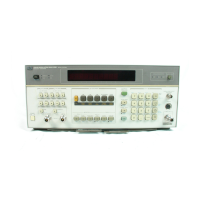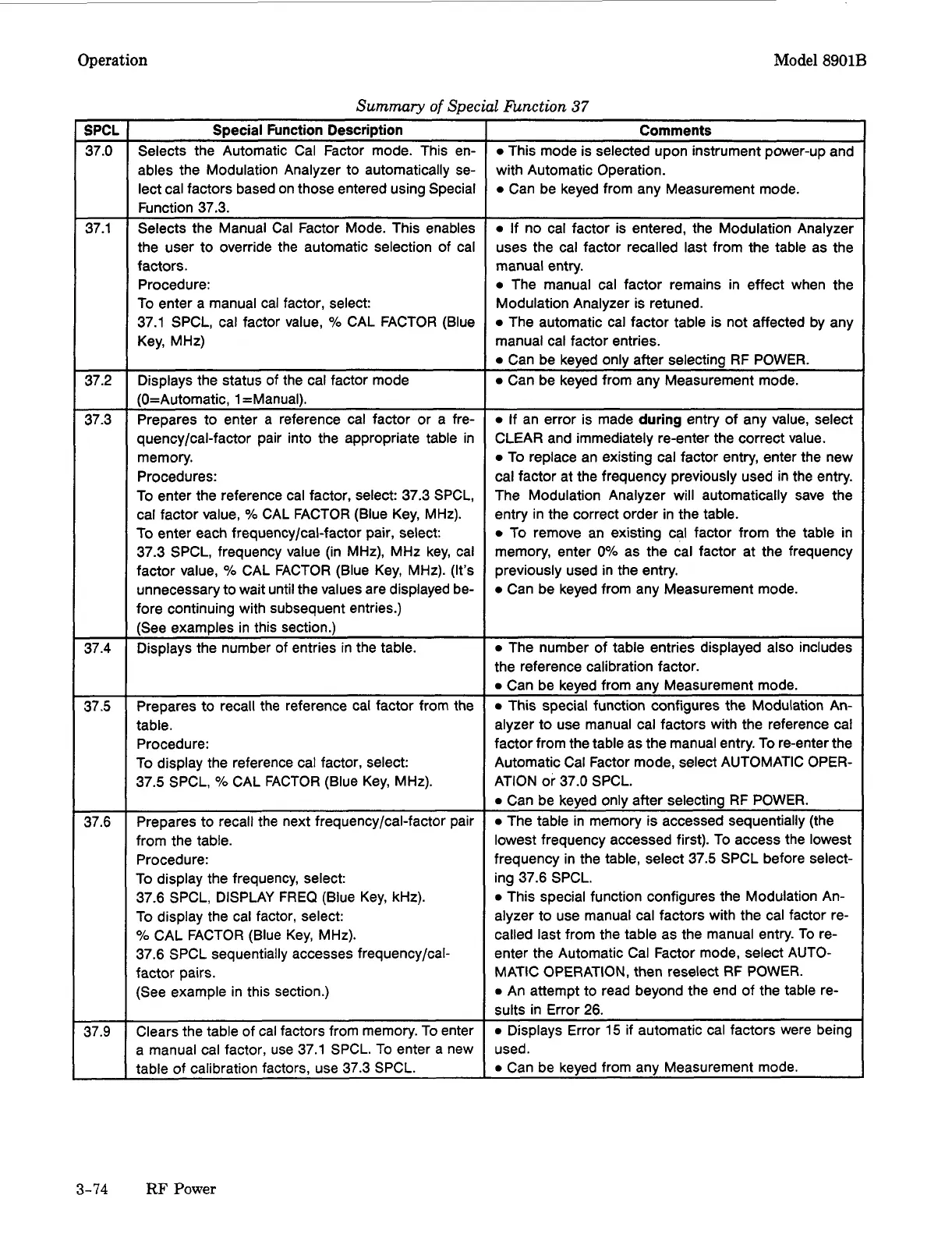Operation Model 8901B
Summary
of
Special finction
37
Special Function Description
Selects the Automatic Cal Factor mode. This en-
ables the Modulation Analyzer to automatically se-
lect cal factors based on those entered using Special
Function 37.3.
Selects the Manual Cal Factor Mode. This enables
the user to override the automatic selection of cal
factors.
Procedure:
To enter a manual cal factor, select:
37.1 SPCL, cal factor value,
YO
CAL FACTOR (Blue
Key, MHz)
~~
Displays the status of the cal factor mode
[O=Automatic.
1
=Manual).
~ ~~~~~
Prepares to enter a reference cal factor
or
a fre-
quencylcal-factor pair into the appropriate table in
memory.
Procedures:
To enter the reference cal factor, select: 37.3 SPCL,
cal factor value,
YO
CAL FACTOR (Blue Key, MHz).
To enter each frequencylcal-factor pair, select:
37.3 SPCL, frequency value (in MHz), MHz key, cal
factor value,
YO
CAL FACTOR (Blue Key, MHz). (It’s
unnecessary to wait until the values are displayed be-
fore continuing with subsequent entries.)
(See examples in this section.)
Displays the number of entries in the table.
Prepares to recall the reference cal factor from the
table.
Procedure:
To display the reference cal factor, select:
37.5 SPCL,
Yo
CAL FACTOR (Blue Key, MHz).
Prepares to recall the next frequency/cal-factor pair
from the table.
Procedure:
To display the frequency, select:
37.6 SPCL, DISPLAY FREQ (Blue Key, kHz).
To display the cal factor, select:
Yo
CAL FACTOR (Blue Key, MHz).
37.6 SPCL sequentially accesses frequency/caC
factor pairs.
(See example in this section.)
Clears the table of cal factors from memory. To enter
a manual cal factor, use 37.1 SPCL. To enter a new
table of calibration factors, use 37.3 SPCL.
Comments
0
This mode is selected upon instrument power-up and
with Automatic Operation.
0
Can be keyed from any Measurement mode.
0
If no cal factor is entered, the Modulation Analyzer
uses the cal factor recalled last from the table as the
manual entry.
0
The manual cal factor remains in effect when the
Modulation Analyzer is retuned.
0
The automatic cal factor table is not affected by any
manual cal factor entries.
0
Can be keved onlv after selectina RF POWER.
0
Can be keyed from any Measurement mode.
~~
____~~
____
~~
0
If an error is made
during
entry of any value, select
CLEAR and immediately re-enter the correct value.
0
To replace an existing cal factor entry, enter the new
cal factor at the frequency previously used
in
the entry.
The Modulation Analyzer will automatically save the
entry in the correct order in the table.
0
To remove an existing cal factor from the table in
memory, enter
0%
as the cal factor at the frequency
previously used in the entry.
0
Can be keyed from any Measurement mode.
0
The number of table entries displayed also includes
the reference calibration factor.
0
Can be keyed from any Measurement mode.
0
This special function configures the Modulation An-
alyzer to use manual cal factors with the reference cal
factor from the table as the manual entry. To re-enter the
Automatic Cal Factor mode, select AUTOMATIC OPER-
ATION
or
37.0 SPCL.
0
Can be keved onlv after selectina RF POWER.
0
The table in memory is accessed sequentially (the
lowest frequency accessed first). To access the lowest
frequency in the table, select 37.5 SPCL before select-
ing 37.6 SPCL.
0
This special function configures the Modulation An-
alyzer to use manual cal factors with the cal factor re-
called last from the table as the manual entry. To re-
enter the Automatic Cal Factor mode, select AUTO-
MATIC OPERATION, then reselect
RF
POWER.
0
An attempt to read beyond the end of the table re-
sults in Error 26.
0
Displays Error 15
if
automatic cal factors were being
used.
0
Can be keved from anv Measurement mode.
3-74
RF
Power

